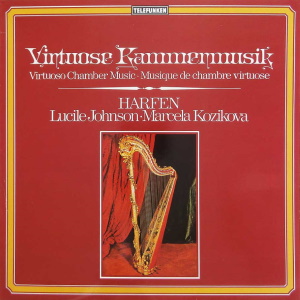 |
1 LP -
Telefunken 6.42628 AP (p) 1979
|
|
| VIRTUOSE KAMMERMUSIK - Harfen |
|
|
|
|
|
|
|
| Maurice Ravel
(1875-1937) |
Introduction
et Allegro |
|
11' 19" |
A1 |
| Claude Debussy
(1862-1918) |
Danses
sacrée et profane |
|
10' 13" |
A2 |
|
- Danse
sacrée: Très modéré |
|
|
|
|
- Danse profane:
Modéré |
|
|
|
| Camille
Saint-Saëns (1835-1921) |
Morceau de
concert, Op. 154 |
|
15' 09" |
B1 |
| Albert Roussel (1869-1937) |
Impromptu,
Op. 21 |
|
7' 54" |
B2 |
|
|
|
|
|
| Lucile JOHNSON
& Marcela KOZIKOVA, Harfen |
|
|
|
|
Luogo
e data di registrazione |
|
-
|
|
|
Registrazione:
live / studio |
|
studio |
|
|
Recording
Supervision
|
|
-
|
|
|
Edizione LP |
|
TELEFUNKEN
- 6.42628 AP - (1 LP - durata 44'
35") - (p) 1979 - Analogico |
|
|
Originale LP
|
|
- |
|
|
Prima Edizione CD |
|
-
|
|
|
Note |
|
Produced
by DESMAR
|
|
|
|
|
It was for
the chromatic harp
that Debussy wrote
the Danses sacrée
et profane in
1904. Although the
Danses are played
almost exclusively
on the double
action harp today,
the compositional
restrictions which
the chromatic harp
imposed on Debussy
are still
apparent; most
obvious, perhaps,
is the fact that
there are no
glissandi in the
piece at all.
Pleyel's
commission to
Debussy did not
escape the notice
of Erard, who in
1905 commissioned
Ravel to compose a
piece fo the
double action
harp. We know from
the composer's
letter to Jean
Marnold that
introduction and
Allegro cost him
at least "a week
of continuous work
and three
sleepless nights."
Ravel himself
throught very
highly of the
piece.
In its original
form the work was
second for harp,
string, string
quartet, flute,
and clarinet. In
this performance,
it has been
adapted - along
with the other
works on this disc
- for two harps.
This was possible
since the flute
and clarinet
always play along
with the strings,
creating thereby a
dialogue with the
harp rather than a
concerto grosso
texture.
The Allegro, which
is basically in
sonata form,
includes a
brilliant cadenza
which uses every
pedal of the
double action harp
in all possible
positions. In this
performance the
cadenza is
sensitively
executed by Miss
Johnson.
Albert Roussel
(1869-1937)
composed the
Impromptu, Op. 21
in 1919 for the
eminent harpist
Lily Laskine (b.
1893). The work is
cast in sonatina
form i. e. a
sonata without
development
section). It is
built on an
artificial scale,
F#, G#, Ab, A#,
Cb, D#, E#, which,
according to the
Roussel scholar,
Basil Deane, was
one of the
composer's
favourite scales.
The Impromptu,
along with the
Sérénade, Op. 30,
has established
itself as one of
the staples of the
harpist's
repertoire.
The Morceau de
concert, Op. 154
of Camille
Saint-Saëns
(1835-1921), also
dates from 1919.
This piece, which
was dedicated to
Nicole Anckier,
uses more
traditional
harmonic resources
than the works of
the other three
composers. The
second harp part,
which assumes the
role of the
orchestra here, is
based on a piano
reduction made by
Saint-Saëns
himself.
··········
Lucile
Johnson and
Marcela
Kozikova
come from
different
cultures,
different
generations, and
different schools
of harp playing.
Miss Johnson
studied harp with
Carlos Salzedo and
Marcel Tournier
(one of Alphonse
Jean Hasselmans
most renowned
pupils), and has
long been regarded
as one of
America's finest
harpists. Her
active career has
included a
teaching position
at the Eastman
School of Music as
well as a seat as
first-chair
harpist in the
Pittsburgh
Symphony under
Fritz Reiner. Miss
Kozikova studied
at the Academy of
Arts in her native
Prague, and later
studied with
Marcel Grandjany
and Sophia
Berhout. She is a
well-known concert
artist and has
recorded for
Supraphon in
Prague.
|
|
|

